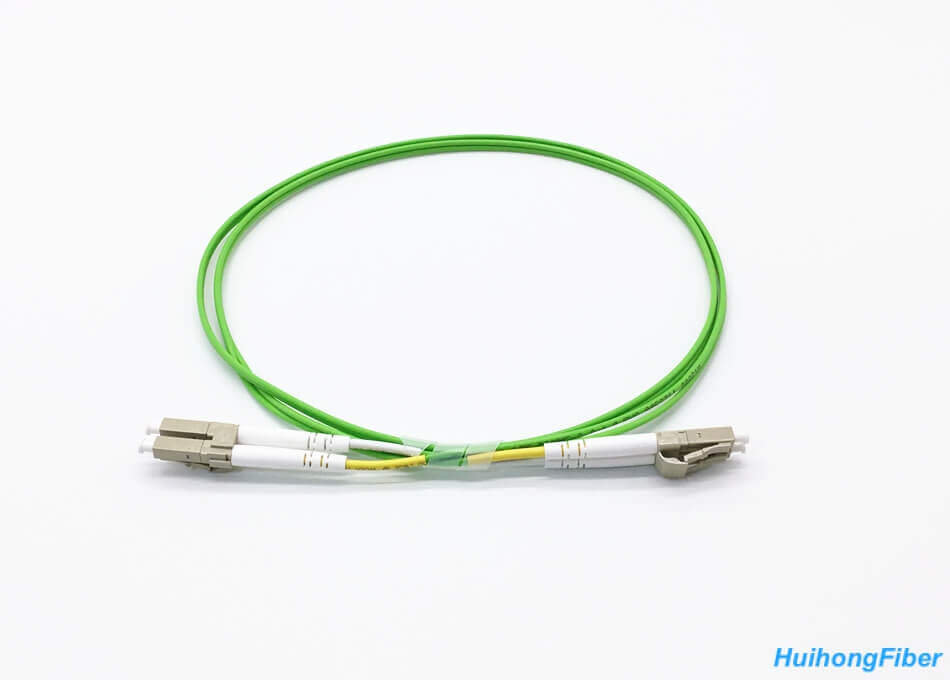High-quality, low-cost 50/125 m OM5 broadband multimode curved insensitive fiber optic cable The OM5 broadband multimode ben insensitive fiber optimized for multi-wavelength transmission systems operating in the 850-950nm range provides optimal support for the emerging SWDM application, which reduces the number of parallel fibers by at least four times.
Only two fibers (instead of eight) are allowed to be used to transmit 40 GB/s and 100 GB/s and reduce high-speed fiber counts. The OM5 meets the requirements of the TIA-492AAE and IEC 60793-2-10 A1A.4 drafts and is fully backward compatible with existing OM4 networks and applications. It complies with RoHS standards, and fiber jumpers are optically tested for insertion losses to ensure high quality.
| Parameters | Value | Parameters | Value |
|---|---|---|---|
| Connector Type | LC to LC | Polish Type | UPC to UPC |
| Fiber Mode | OM5 50/125μm | Wavelength | 850/1300nm |
| 40G Ethernet Distance | 440m at 850nm | 100G Ethernet Distance | 150m at 850nm |
| Insertion Loss | ≤0.3dB | Return Loss | ≥20dB |
| Fiber Grade | Bend Insensitive | Minimum Bend Radius | 7.5mm |
| Attenuation at 850nm | 3.0 dB/km | Attenuation at 1300nm | 1.0 dB/km |
| Effective Modal Bandwidth (at 850nm) | ≥4700 MHz·km | Effective Modal Bandwidth (at 953nm) | ≥2470 MHz·km |
| Fiber Count | Duplex | Cable Diameter | 2.0mm |
| Cable Jacket | PVC | Polarity | A(Tx) to B(Rx) |
| Operating Temperature | -20~80°C | Storage Temperature | -40~80°C |
The OM5 is essentially an OM4 fiber with additional bandwidth specifications at 953nm. The bandwidth of the OM4 and OM5 is 4,700MHz km at 850nm, while the bandwidth specification for the OM5 is defined as 2,450MHz km at 953nm.
The OM4 does not define the corresponding bandwidth specification at 953nm. OM5 is designed for optical transceiver module applications for short wave multiplexing (SWDM).
The new SWDM transceiver module uses four wavelengths, spanning from 850nm to 953nm, enabling the transmission of 100Gbps. Each wavelength is modulated at 25Gbps, multiplexing these wavelengths, allowing the entire link to reach 100Gbps. See Figure 1. Given the wavelength used in sWDM short wave split multiplexing optical modules, it is easy to understand why the OM5 standard should be developed.
If you plan to deploy a 100Gbps link using the SWDM Short Wave Split Multiplex optical module and need to reach more than 100 meters, you only need to consider using OM5 broadband multimode fiber. The advantage of using SWDM short wave split multiplexing optical modules is that they allow 100Gbps to be deployed on the duplex MMF instead of consuming the required eight parallel fibers when using 100GBASE-SR4.
SWDM short wave split multiplexing technology allows the re-use of existing infrastructure based on duplex fiber transmission system components.
However, there are many more desirable alternatives to deploying 100Gbps on duplex fibers, such as 100G Bidi, or using PAM4 modulation to achieve higher data rates. Alternatives are not affected by deficiencies in sWDM short wave multi-use optical modules, such as high costs, operating temperatures, and inability to support branch applications.
If you are still considering using the SWDM 100G short wave split multiplexing optical module with a transmission distance of less than 100 meters, a compromise is to use the standard OM3 or OM4 because they are cheaper than OM5. If you need to extend the distance, say, using a 40G Bidi, the best alternative for OM5 fiber is to use our OM4 MMF.
Our OM4 MMF can reach a transmission distance of 200 meters with 40G Bidi, while the OM5 can only reach 150 meters, the same as the OM4. The reason is that the OM5 fiber performs no better than the OM4 at the wavelength used by the Bidi module.
In fact, the OM4 has outperformed the standard OM5 fiber in many head-on encounters with end users. If you decide to use a 100G SWDM short wave split multiplexing optical module and you need to transfer more than 150 meters, it is best to use our OM5 MMF. The OM5 MMF uses the same enhanced transfer distance technology as the OM4, so you can take advantage of this transfer distance that exceeds the standard 20%.

